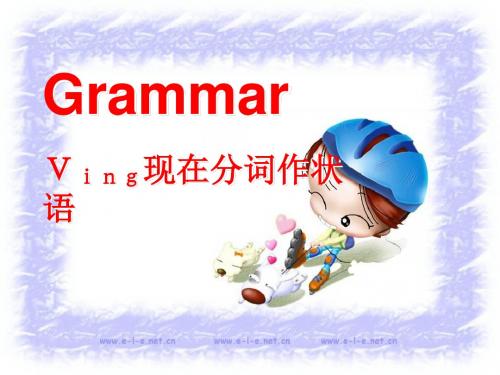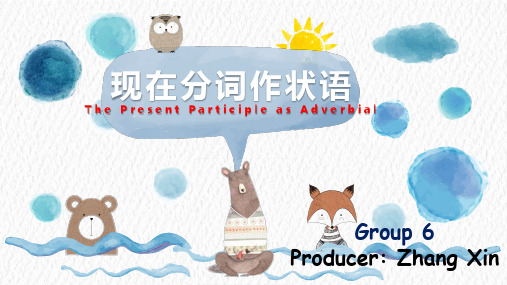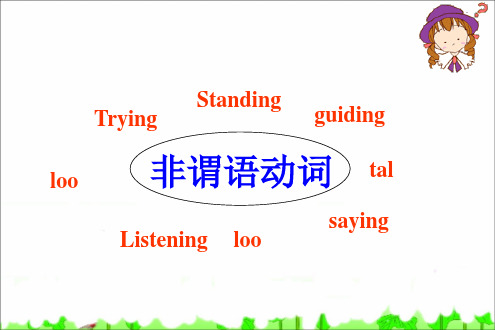现在分词作状语.ppt
合集下载
高中英语 语法 现在分词作状语(共31张PPT)

他句子成份。
需要注意的事项
1. V-ing 形式
V-ing 形式由 “do+ing” 构成, V-ing 可以带宾语或状 语构成 V-ing 短语, 没有人称和数的变化, 但有时态 和语态的变化。
否定形式: not doing 语态:主动或被动 时态:当分词的动作完成以后,主句的动作才发生时,
用现在分词的完成形式作状语。
The person _t_r_a_n_s_la_t_in_g_t_h_e_s_o_n_g_s_can speak seven languages.
3. The boy standing there is reading a book about body language.
The boy _w_h_o_ _is_ _s_t_a_n_d_in_g_ there is reading a book about body language. 4. Because he comes from Jordan, he moves close to ask you a question.
is my father. 定语
When meeting guests, he often felt uneasy.
表时间
Not knowing her telephone number, I didn’t
phone her.
表原因
Turning to the left, you’ll see a school.
When leaving the station, he waved again and again to me.
3. 现在分词作状语时,有时可以在分词前加 once, although, though, until, if 等连词。
需要注意的事项
1. V-ing 形式
V-ing 形式由 “do+ing” 构成, V-ing 可以带宾语或状 语构成 V-ing 短语, 没有人称和数的变化, 但有时态 和语态的变化。
否定形式: not doing 语态:主动或被动 时态:当分词的动作完成以后,主句的动作才发生时,
用现在分词的完成形式作状语。
The person _t_r_a_n_s_la_t_in_g_t_h_e_s_o_n_g_s_can speak seven languages.
3. The boy standing there is reading a book about body language.
The boy _w_h_o_ _is_ _s_t_a_n_d_in_g_ there is reading a book about body language. 4. Because he comes from Jordan, he moves close to ask you a question.
is my father. 定语
When meeting guests, he often felt uneasy.
表时间
Not knowing her telephone number, I didn’t
phone her.
表原因
Turning to the left, you’ll see a school.
When leaving the station, he waved again and again to me.
3. 现在分词作状语时,有时可以在分词前加 once, although, though, until, if 等连词。
现在分词作状语(公开课课件)

学习者需求
对于汉语作为第二语言的学习者来说,掌握现在分词作 状语的用法对于提高语言表达的准确性和流利度具有重 要意义。
课程目的
01 知识目标
使学习者了解现在分词作状语的基本概念、用法 和特点。
02 能力目标
通过讲解和练习,使学习者能够正确运用现在分 词作状语,提高语言表达水平。
03 情感目标
培养学习者对汉语语法的兴趣,增强学习汉语的 自信心。
让步状语
表示让步,常用现在分词的一般式。例如
Although raining heavily, they still went out. (尽管雨下得很大,他们还是出去了。)
表示转折的让步,常用现在分词的完成式。例如
Having failed many times, he didn't lose heart. (尽管失败了很多次,他并没有丧失 信心。)
作表语
现在分词作表语时,通常放在系动词 后面,表示主语的特征或状态。如:
The film is very moving.(表语)
作定语
现在分词作定语时,通常放在被修饰 的名词前面,表示主动和进行。如: The rising sun is very beautiful. (定语)
作补足语
现在分词作补足语时,通常放在感官 动词或使役动词后面,表示主动和进 行。如:I heard someone singing in the next room.(补足语)
Given more time, we could have done it better. 如果给我们更多的时 间,我们可以做得更好。
实例三:原因状语
Being ill, he didn't go to school. 他因为生病,所以没有去 上学。
对于汉语作为第二语言的学习者来说,掌握现在分词作 状语的用法对于提高语言表达的准确性和流利度具有重 要意义。
课程目的
01 知识目标
使学习者了解现在分词作状语的基本概念、用法 和特点。
02 能力目标
通过讲解和练习,使学习者能够正确运用现在分 词作状语,提高语言表达水平。
03 情感目标
培养学习者对汉语语法的兴趣,增强学习汉语的 自信心。
让步状语
表示让步,常用现在分词的一般式。例如
Although raining heavily, they still went out. (尽管雨下得很大,他们还是出去了。)
表示转折的让步,常用现在分词的完成式。例如
Having failed many times, he didn't lose heart. (尽管失败了很多次,他并没有丧失 信心。)
作表语
现在分词作表语时,通常放在系动词 后面,表示主语的特征或状态。如:
The film is very moving.(表语)
作定语
现在分词作定语时,通常放在被修饰 的名词前面,表示主动和进行。如: The rising sun is very beautiful. (定语)
作补足语
现在分词作补足语时,通常放在感官 动词或使役动词后面,表示主动和进 行。如:I heard someone singing in the next room.(补足语)
Given more time, we could have done it better. 如果给我们更多的时 间,我们可以做得更好。
实例三:原因状语
Being ill, he didn't go to school. 他因为生病,所以没有去 上学。
分词作状语(共24张PPT)

详细描述
这道练习题将提供一些含有分词作状语的错误句子,要求 学生识别并纠正错误,提高对分词作状语用法的敏感度和 准确性。
总结词
理解分词作状语在复杂句型中的作用
详细描述
这道练习题将通过一些复杂句型,让学生理解分词作状语 在句子中的衔接和修饰作用,以及如何运用分词作状语来 简化复杂句型。
总结词
掌握分词作状语与从句的转换技巧
详细描述
分词短语可以用来描述动作的目的或 意图,例如“为了减肥,我每天早上 跑步。”中的“为了减肥”就是一个 目的状语,表示“我每天早上跑步” 这个动作的目的是减肥。
让步状语
01
让步状语
分词短语表示动作发生的让步条件,通常放在句首或句末 。
02
总结词
表示动作发生的让步条件。
03
详细描述
分词短语可以用来描述动作发生的让步条件,例如“尽管 下雨了,我们还是去了野餐。”中的“尽管下雨了”就是 一个让步状语,表示“我们还是去了野餐”这个动作是在 下雨这个不利条件下发生的。
04
详细描述
这道练习题将重点讲解分词作状语的 时态和语态变化,帮助学生理解不同 时态和语态下分词的使用规则。
06
详细描述
通过这道练习题,学生将进一步提高分词作状 语的运用准确度,避免常见的语法错误,使语 言表达更加规范、准确。
练习题五
总结词
综合运用分词作状语的能力
详细描述
这道练习题将综合考察学生对分词作状语的掌握程度,要求学生在实际语境中灵活运用这一语法点, 提高综合语言运用能力。
总结词
表示动作发生的条件或前提。
详细描述
分词短语可以用来描述动作发生的条件或前提,例如“如果下雨了,我们就不去野餐了。”中的“如果 下雨了”就是一个条件状语,表示“我们就不去野餐了”这个动作发生在下雨这个条件下。
这道练习题将提供一些含有分词作状语的错误句子,要求 学生识别并纠正错误,提高对分词作状语用法的敏感度和 准确性。
总结词
理解分词作状语在复杂句型中的作用
详细描述
这道练习题将通过一些复杂句型,让学生理解分词作状语 在句子中的衔接和修饰作用,以及如何运用分词作状语来 简化复杂句型。
总结词
掌握分词作状语与从句的转换技巧
详细描述
分词短语可以用来描述动作的目的或 意图,例如“为了减肥,我每天早上 跑步。”中的“为了减肥”就是一个 目的状语,表示“我每天早上跑步” 这个动作的目的是减肥。
让步状语
01
让步状语
分词短语表示动作发生的让步条件,通常放在句首或句末 。
02
总结词
表示动作发生的让步条件。
03
详细描述
分词短语可以用来描述动作发生的让步条件,例如“尽管 下雨了,我们还是去了野餐。”中的“尽管下雨了”就是 一个让步状语,表示“我们还是去了野餐”这个动作是在 下雨这个不利条件下发生的。
04
详细描述
这道练习题将重点讲解分词作状语的 时态和语态变化,帮助学生理解不同 时态和语态下分词的使用规则。
06
详细描述
通过这道练习题,学生将进一步提高分词作状 语的运用准确度,避免常见的语法错误,使语 言表达更加规范、准确。
练习题五
总结词
综合运用分词作状语的能力
详细描述
这道练习题将综合考察学生对分词作状语的掌握程度,要求学生在实际语境中灵活运用这一语法点, 提高综合语言运用能力。
总结词
表示动作发生的条件或前提。
详细描述
分词短语可以用来描述动作发生的条件或前提,例如“如果下雨了,我们就不去野餐了。”中的“如果 下雨了”就是一个条件状语,表示“我们就不去野餐了”这个动作发生在下雨这个条件下。
现在分词作伴随状语ppt

eg.
伴随
Accompany
1. He died doing what made him happiest.
2. He laughed looking at the funny boy.
3. Tony came into the room, singing and dancing.
Let's do some exercise.
现在分词作状语
The Present Participle as Adverbial
Group 6 Producer: Zhang Xin现添加在题 分词作状语可以表示结果
Rusult
原因
Cause
时间
Time
条件 让步 添加
Condition Concessi标on方题 式
Manner
或
伴随
Accompany
伴随状语首先是一种状语,用来修饰 动词的,
同时是表示与谓语动词同时进行, 即伴随着谓语动词的动作同时进行。
eg.
伴随
Accompany
He said it angrily pointing
at the notice on the wall.
这里,point与said同时进行,因此, pointing在这里是现在分词作伴随 状语,表示主动和正在进行。
books.
6.He lay on the grass, _s_ta_r_i_n_g (stare) at the sky
for a time.
7.He sat there _th_i_n_k_in_g_ (think), with his head on
his hands. 8.The secretary worked late into the night,
现在分词作状语公开课PPT文档共24页

现在分词作状语公开课
46、法律有权打破平静。——马·格林 47、在一千磅法律里,没有一盎司仁 爱。— —英国
48、法律一多,公正就少。——托·富 勒 49、犯罪总是以惩罚相补偿;只有处 罚才能 使犯罪 得到偿 还。— —达雷 尔
50、弱者比强者更能得到法律的保护 。—— 威·厄尔
56、书不仅是生活,而且是现在、过 去和未 来文化 生活的 源泉。 ——库 法耶夫 57、生命不可能有两次,但许多人连一 次也不 善于度 过。— —吕凯 特 58、问渠哪得清如许,为有源头活水来 。—— 朱熹 59、我的努力求学没有得到别的好处, 只不过 是愈来 愈发觉 自己的 无知。 ——笛 卡儿
拉
60、生活的道路一旦选定,就要勇敢地 走到底 ,决不 回头。 ——左
46、法律有权打破平静。——马·格林 47、在一千磅法律里,没有一盎司仁 爱。— —英国
48、法律一多,公正就少。——托·富 勒 49、犯罪总是以惩罚相补偿;只有处 罚才能 使犯罪 得到偿 还。— —达雷 尔
50、弱者比强者更能得到法律的保护 。—— 威·厄尔
56、书不仅是生活,而且是现在、过 去和未 来文化 生活的 源泉。 ——库 法耶夫 57、生命不可能有两次,但许多人连一 次也不 善于度 过。— —吕凯 特 58、问渠哪得清如许,为有源头活水来 。—— 朱熹 59、我的努力求学没有得到别的好处, 只不过 是愈来 愈发觉 自己的 无知。 ——笛 卡儿
拉
60、生活的道路一旦选定,就要勇敢地 走到底 ,决不 回头。 ——左
过去分词,现在分词作状语.ppt

• Exhausted by the running, they went on running after the robber. • 尽管已经跑得筋疲力尽,他们还是继续追赶着那 个强盗。 • Laughed at by many people, he continued his study. • 尽管被许多人嘲笑,他还是继续他的研究。 • The old man went into the room, supported by his wife.那个老人在他的妻 子的搀扶下走进了房间。
• 如: • amusing, amused; encouraging, encouraged; disappointing, disappointed; exciting, excited; puzzling, puzzled; satisfying, satisfied; worrying, worried; tiring, tired; pleasing, pleased; interesting, interested; astonishing, astonished
• Given another chance, he will do better. • 再给他一次机会,他会做得更好。 • Compared with your brother, you should make greater efforts to study English. • 和你哥哥相比,你应该更加努力学习英语。 • If heated, water can be turned into steam. • 水如果被加热,会变成水蒸气。
过去分词作定语
• Autumn comes, and there are many fallen leaves on the street. • There is nothing changed in my hometown since 1999. • Most of the guests invited to my birthday party were my school friends. • = Most of the guests who were invited to my birthday party were my school friends.
现在分词作状语市级公开课课件

学生互动环节:提问和答疑
学生提问
在这一环节,我们将鼓励学生提出自己 在学习过程中遇到的问题和困惑,以便 更好地解决他们的疑惑,提高学习效果 。
VS
教师答疑
教师将针对学生们提出的问题进行详细的 解答和指导,帮助学生更好地理解和掌握 现在分词作状语的用法和技巧。
课后作业和自学建议
布置课后作业
为了巩固学生的学习成果,我们将布置与现 在分词作状语相关的课后作业,要求学生在 规定时间内完成并提交。
05
现在分词作状语的实践应 用
现在分词作状语在口语和书面语中的应用
要点一
生动形象
要点二
修饰谓语
在口语中,现在分词作状语可以生动形象地描述动作或状 态,使语言更加生动有趣。例如,“笑着说”比“笑着说 道”更简洁生动。
在书面语中,现在分词作状语可用于修饰谓语,进一步描 述动作的方式或伴随情况,增强语言的准确性。例如,“ 他悄悄地走进了房间”,“悄悄”作为现在分词作状语, 修饰了“走进”。
课程大纲和安排
大纲:本课程将分为 以下几个部分进行讲 解
2. 现在分词作状语的 用法及示例;
1. 现在分词作状语的 概念和分类;
课程大纲和安排
3. 与现在分词作状语相关的注意事项; 4. 练习与巩固。
安排:课程总时长为90分钟,具体安排如下
课程大纲和安排
1. 导入(5分钟)
01
简要介绍课程目标和内容;
实例分析
通过分析经典文学作品中的现在分词作状语实例,深 入了解其在文学创作中的独特魅力和表达效果,提升 对现在分词作状语的欣赏和理解能力。例如,钱钟书 《围城》中的“他低头默默走着,心里琢磨着那封信 ”。这里的“低头默默走着”和“琢磨着那封信”都 是现在分词作状语,传神地描绘了主人公的内心状态 和动作。
现在分词作状语有几种形式课件

5
(1)相当于原因状语从句
a. Being ill, she didn’t go to school today.
=As she is ill, …
b. Having seen the film ,he didn’t go to the cinema
with them.
=Because he had seen the
having received D. Having not received
作原因状语
现在分词作原因状语,分词结构中否 定词通常放在现在分词前面。
22
单句改错
1. Having not seen the film, I
can’t tell you what INtohtinhkavoifngit. 2. The men worked for extra hours
2.European football is played in 80 couAntries, ______ it the most popular sport in the worl现d.在分词表结果状语
A. Making make
B. makes
C. made D. to
20
3. “Can’t you read?” Mary sAaid _______ to the notice.
8
(4)表示结果
a. The old man died, leaving nothing but debts.
9
(5)表示条件 If playing all day ,you will waste your valuable time.
10
比较现在分词和过去分词作状语的区别
1. Following the old man, we went upstairs.
(1)相当于原因状语从句
a. Being ill, she didn’t go to school today.
=As she is ill, …
b. Having seen the film ,he didn’t go to the cinema
with them.
=Because he had seen the
having received D. Having not received
作原因状语
现在分词作原因状语,分词结构中否 定词通常放在现在分词前面。
22
单句改错
1. Having not seen the film, I
can’t tell you what INtohtinhkavoifngit. 2. The men worked for extra hours
2.European football is played in 80 couAntries, ______ it the most popular sport in the worl现d.在分词表结果状语
A. Making make
B. makes
C. made D. to
20
3. “Can’t you read?” Mary sAaid _______ to the notice.
8
(4)表示结果
a. The old man died, leaving nothing but debts.
9
(5)表示条件 If playing all day ,you will waste your valuable time.
10
比较现在分词和过去分词作状语的区别
1. Following the old man, we went upstairs.
现在分词做伴随状语课件

现在分词可以作为形容词使用, 用来修饰名词或代词,表示正在 进行的动作或存在的状态。例如: "The singing girl is my sister." (以作为名词使用, 在句中充当主语或宾语。例如: "Watching TV is my favorite hobby."(看电视是我最喜欢的爱 好。)
语法特点
现在分词可以作为形容词或名词使用,可以用来修饰名词或动词,或者在句中充当主语、 宾语、表语等。
变化规则
现在分词的变化规则与动词的现在分词形式相同,一般动词在词尾加上"-ing"即可,但有 些动词需要使用特殊的现在分词形式,如"be动词"的现在分词形式为"being"。
现在分词的用法
用作形容词
纠错和改进
VS
详细描述
本题为现在分词做伴随状语的纠错和改进 题,旨在考察学生对现在分词做伴随状语 在句子中出现的错误形式的识别和修正能 力。
05
总结与归纳
伴随状语的用法总结
伴随状语是用来修饰动词、形容词或整个句子的,表示动作的状态、方式、伴随等 关系。
伴随状语通常由一个分词短语或一个独立主格结构来担任,可以放在句首或句尾。
03
常见错误分析
现在分词误用为谓语动词
总结词
现在分词不能用作谓语动词,否则句子的谓语动词会缺失。
详细描述
现在分词是动词的一种形式,它保留了动词的部分特征,但 并不具备完整的谓语功能。在使用现在分词时,需要注意它 不能作为句子的谓语动词,否则会导致句子结构不完整和表 达不清晰。
现在分词与句子主语不一致
伴随状语的构成
现在分词
表示正在进行的动作或存在的状 态,例如“walking on the street”。
语法特点
现在分词可以作为形容词或名词使用,可以用来修饰名词或动词,或者在句中充当主语、 宾语、表语等。
变化规则
现在分词的变化规则与动词的现在分词形式相同,一般动词在词尾加上"-ing"即可,但有 些动词需要使用特殊的现在分词形式,如"be动词"的现在分词形式为"being"。
现在分词的用法
用作形容词
纠错和改进
VS
详细描述
本题为现在分词做伴随状语的纠错和改进 题,旨在考察学生对现在分词做伴随状语 在句子中出现的错误形式的识别和修正能 力。
05
总结与归纳
伴随状语的用法总结
伴随状语是用来修饰动词、形容词或整个句子的,表示动作的状态、方式、伴随等 关系。
伴随状语通常由一个分词短语或一个独立主格结构来担任,可以放在句首或句尾。
03
常见错误分析
现在分词误用为谓语动词
总结词
现在分词不能用作谓语动词,否则句子的谓语动词会缺失。
详细描述
现在分词是动词的一种形式,它保留了动词的部分特征,但 并不具备完整的谓语功能。在使用现在分词时,需要注意它 不能作为句子的谓语动词,否则会导致句子结构不完整和表 达不清晰。
现在分词与句子主语不一致
伴随状语的构成
现在分词
表示正在进行的动作或存在的状 态,例如“walking on the street”。
高三英语---现在分词作状语(共16张PPT)

2.Being punished by the teacher, the boy was angry. (__原___因__ 状语) = _B__e_c__a_u_s__e_ the boy was punished by the teacher, he was angry.
3.Having been praised for his job, Tom worked harder.(__原___因___状语) =B_e_c__a_u_s__eTom has been praised for his job, he worked harder. 4.Having received his letter, I decided to write back. (_时___间___ 状语) =__A__ft_e_r___ I received his letter, I decided to write back.
如果时间允许,我们将做另两个练习。
Summary
现在分词作状语
状语从句
语态
时态
逻辑主语
伴随状语
Q3: Having been in love with her for many years, Zhang Jie is married with her. Who is she ?
原因状语
Q4: Preparing fully, he may catch a sheep. But at last, he still failed because of the sheep’s intelligence.
条件状语
1 Guidance and Exploration 1 : 思考:观察下现面在两分个词句作子状,语可与以状用语状从语句从互句换改写吗? Having been in love with her for many years, Zhang Jie is married with her.(原因状语)
3.Having been praised for his job, Tom worked harder.(__原___因___状语) =B_e_c__a_u_s__eTom has been praised for his job, he worked harder. 4.Having received his letter, I decided to write back. (_时___间___ 状语) =__A__ft_e_r___ I received his letter, I decided to write back.
如果时间允许,我们将做另两个练习。
Summary
现在分词作状语
状语从句
语态
时态
逻辑主语
伴随状语
Q3: Having been in love with her for many years, Zhang Jie is married with her. Who is she ?
原因状语
Q4: Preparing fully, he may catch a sheep. But at last, he still failed because of the sheep’s intelligence.
条件状语
1 Guidance and Exploration 1 : 思考:观察下现面在两分个词句作子状,语可与以状用语状从语句从互句换改写吗? Having been in love with her for many years, Zhang Jie is married with her.(原因状语)
《现在分词作状语》课件

05
现在分词作状语的练习与巩固
选择题练习
总结词
通过选择题练习,学生可以加深对现在分词作状语的理 解,提高对相关句子的辨识能力。
详细描述
设计一系列关于现在分词作状语的选择题,每个题目提 供四个选项,让学生根据句子语境选择正确的答案。题 目难度可以根据学生实际情况进行调整,从简单到复杂 ,逐步提高难度。
让步状语
总结词
表示动作发生的让步条件
详细描述
现在分词短语用作让步状语时,通常放在句 首或句末,表示某个动作发生的让步条件。 例如,“Despite being tired, he insisted
on finishing the work.”(尽管累了,他 还是坚持完成了事项
详细描述
设计一系列中英文互译的翻译题,让学生将含有现在分 词作状语的英文句子翻译成中文,或者将含有相应中文 句子的英文句子翻译成中文。通过翻译实践,学生可以 更好地掌握现在分词作状语的用法,提高语言水平。同 时,教师还可以根据学生的实际水平,提供不同难度的 翻译题目,以满足不同层次学生的学习需求。
THANKS
条件状语
总结词
表示某个动作发生的条件
详细描述
现在分词短语用作条件状语时,通常放在句首或句末,表示某个动作发生的条件。例如 ,“Hearing the news, they immediately set off to the airport.”(听到消息后,
他们立刻出发去机场。)
伴随状语
总结词
表示动作发生时伴随的情况或结果
《现在分词作状语》 ppt课件
contents
目录
• 现在分词作状语的概述 • 现在分词作状语的形式 • 现在分词作状语的用法 • 现在分词作状语的注意事项 • 现在分词作状语的练习与巩固
高中英语现在分词作状语课件(共26张PPT)

against the ground. (
)
2.动词-ing分词一般式
1. 尽管知道我住在哪里,但他从没来看过我。 _K_n_o_w__in__g__ where I live, he never comes to
see me . Though he knows where I live, he
never comes to see me. 让步状语从句 2. 因为我不知道她的电话号码,所以不能打给 她。 Because I didn’t know her telephone number,
5. _H__a_v_i_n_g__b_e__e_n__t_a_k_e_n___(take) to the lab, we
were taken to the library.
Grammar work: Filling the blanks with –ing form
1. __W__a_lk_i_n_g_s_t_r_a_ig_h_t_____ (一直往前走) , you will
6.从山上看, 我们发现这湖泊更加漂亮了。
If we see from the hill, we find the lake looks more beautiful.
S__e_e_i_n_g_ _f_ro__m_ _t_h_e_h__il_l___, we find that the lake looks more beautiful. -ing分词作条件状语
• Born in Guangzhou, Alice was the only daughter in her family. ‖When she heard the news about Asian Games, she applied to be the first volunteer in her college. ‖ Her parents supported what she had done, and it made her more confident. ‖ Though she was tired , she still did a very good job. ‖ She was considered as the most excellent volunteer, and then Alice was well-known in the college.
- 1、下载文档前请自行甄别文档内容的完整性,平台不提供额外的编辑、内容补充、找答案等附加服务。
- 2、"仅部分预览"的文档,不可在线预览部分如存在完整性等问题,可反馈申请退款(可完整预览的文档不适用该条件!)。
- 3、如文档侵犯您的权益,请联系客服反馈,我们会尽快为您处理(人工客服工作时间:9:00-18:30)。
注意:
动词-ing 形式(现在分词)作状语 时,其逻辑主语必须与句子的主语 一致,且必须与句子的主语是逻辑 上的主谓关系,动词-ing 形式表示 的动作是次要动作。(一个主语多 个动作。)
Grammar 1–1. Choosing
Read the following sentences and make a choice.
用法3: 表示条件,多置于句首
e.g. Working hard, you will succeed.
用法4: 表示让步,多置于句首
e.g. Being poor, the old man was happy.
= Though the old man was poor, he was happy.
__2___3_ describe two things happening at
the same time
_1____4_ describe one thing happening
immediately after another
1. Putting down his shopping bag, Will held out his hand. 2. Will, still watching, saw the cat behave curiously. 3. He crossed the road, keeping his eyes on the spot where the cat had been investigating. 4. Pushing his shopping bag through, he scrambled through himself.
用法2: 表示原因,多置于句首或句末,也可置于
句中。 e.g. 1) Being ill, he didn’t go to school. = Because he was ill, he didn’t go to school.
2) She rang him up, hoping to get his support.
用法10: 在-ing 形式短语前可用though/although 表
示让步
e.g. Though working very hard, he couldn’t make enough money to pay off his debt.
= Though he worked very hard, he couldn’t make enough money to pay off his debt.
3) Before going abroad, he lived here.
4) After watching TV, he went to bed.
用法8: 在-ing形式短语前可用介词on,表示“一……
就……” e.g. On arriving in Beijing, he went to see his uncle. (= As soon as he arrived in Beijing, he went to see his uncle.)
动词的-ing形式(现在分词)作状语
动词的-ing(现在分词)形式作 状语时,通常都表示主语正在进行 的另一动作,用来对谓语动词表示 的动作加以修饰或作为陪衬,它可 表示时间、原因、结果、条件、让 步、方式或伴随动作,相当于相对 应的状语从句。
用法1: 表示时间,多置于句首,也可置于句末。
e.g. Walking in the street, I met a friend of mine.=When I was walking in the street, I met a friend of mine.
Grammar 1-2. Rewrite the
sentences
1.The witch leapt into the air and vanished.
Leaping into the air, the witch vanished.
2.The man shouted angrily and waved his sword at the stranger. Shouting angrily, the man waved his sword at the stranger.
She picked up the cat and rubbed its head affectionately.
Picking up the cat, she rubbed its head affectionately.
The bear came out of theth and made a lot noise. Showing his teeth and making a loud noise, the bear came out of the bushes.
用法7: 为强调与谓语动词的动作同时发生,在ing形式短语前可用连词when, while等; 为强调在谓语动词的动作之前或之后发生, 在-ing形式短语前可用连词before或after e.g. 1) Be careful when crossing the road.
2) Don’t laugh while eating.
用法5: 表示结果,常置于句末
e.g. The boy fell off his bike, breaking his right arm.
用法6: 表示方式或伴随,多置于句末,也可置 于句首。
e.g. 1) He sat at the table, reading a magazine.
2) Laughing and talking, they went into the room.
用法9: 为了强调结果,可在-ing形式前加副词thus e.g. The bus was held up by the snowstorm, thus causing the delay.
(= The bus was held up by the snowstorm, and as a result it caused the delay.)
